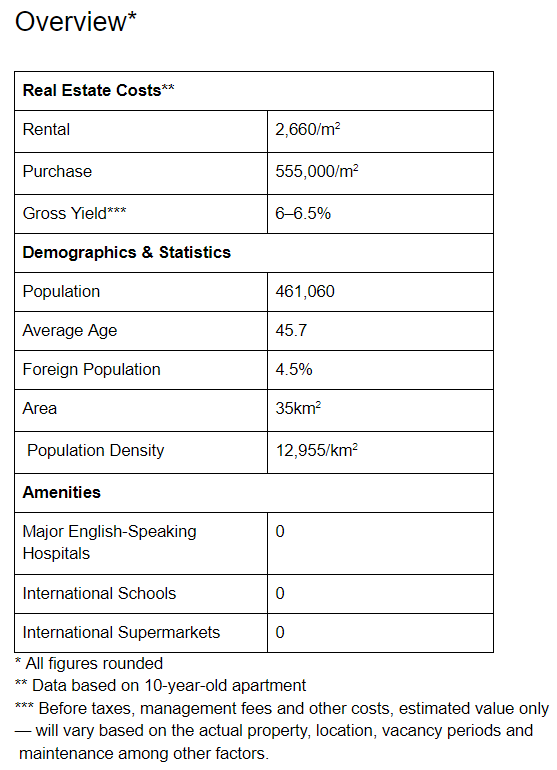Katsushika area overview
Located in the northeastern corner of Tokyo, Katsushika-ku (Katsushika City in English, but commonly known as Katsushika ward) is a ward of 34.8 km2. It is flanked by the Arakawa and Edo rivers. The ward borders both Saitama and Chiba prefectures, which are often considered as part of the Greater Tokyo Area as they are home to many of Tokyo’s commuters.
In Tokyo, it borders Taito, Adachi and Edogawa wards, and together they are known as shitamachi (literally meaning ‘under city’, referring to the geographically lower-lying parts of Tokyo, away from the centre) areas. The area is quiet, away from the busy business and entertainment centres of Tokyo, and offers green spaces and waterways, making it popular with the elderly population of the Japanese capital.
Lifestyle
Idyllic, calm and green are keywords that come to mind when describing Katsushika ward. Bordering the neighbouring prefectures, this area is far from the hustle and bustle of the city centre. No wonder it is favoured by the elderly citizens of the Japanese capital. Devoid of highrises, large shopping complexes or other signs of modern Japan, the area preserved a Showa-style charm, the era synonymous with progress and prosperity in post-WWII Japan.
Several famous temples are dotted across Katsushika, especially in the Shibamata area that is often compared to the more famous and touristy Asakusa. The ward is flanked by two of Tokyo’s biggest rivers. Unsurprisingly, some of the local restaurants specialise in fresh-water fish cuisine. Mizomoto is one of Tokyo’s largest parks located in the ward along Edo River and frequented by locals and visitors alike.
Demographics of area
Currently, 461,060 residents are registered in Katsushika ward. With a population density of 12,955/km2, Katsushika ranks lower than most other wards in Tokyo, thanks to its location on the border of the metropolis. The ward has quite a high population of international residents (20,698), most hailing from other Asian countries. With an average age of 45.7 years, Katsushika is only second to Taito as the oldest ward in Tokyo. In general, the northern wards are known as home to Tokyo’s older population
Amenities and attributes
A few of Katsushika stations also feature small (and often a bit dated) malls or shopping areas nearby. Kameari Station has Ario and Lirio malls, while the Your Elm shopping park is close to Aoto Station. However, these hardly keep pace with the fancy malls of central Tokyo. For the rest of the ward, the extent of shopping is limited to shotengai — sometimes-covered shopping streets lined with small, often independent shops offering wares and services.
No international hospitals are located in Katsushika. The ward is serviced by several Japanese hospitals, including the Kameari Hospital, Kanamachi Central Hospital, Katsushika Edogawa Hospital and the IMSTokyo Katsushika General Hospital that may or may not have English-speaking physicians on duty.
Besides the 24-hour gym Anytime Fitness, no other international gym chains have branches in Katsushika; however, several Japanese gyms are scattered throughout the ward.
Katsushika has no international schools.
No international supermarkets are located here, but a big supermarket can be found within walking distance of most stations. Some of the biggest are Ito-Yokado in Tateishi and Big-A in Nishi Kameari.
Shin-Koiwa is one of the ward’s busiest stations located on the Chuo and Sobu Line, about 15 minutes from Tokyo without transfers. A trip to Narita Airport will take you around 1 hour. To Haneda Airport, budget around 50-60 minutes, depending on your connection. Aoto on the Keisei Line is another central station in the ward. A trip to Haneda will take around an hour, while Narita Airport is only 50 minutes away. However, it will take you half an hour to get to Tokyo Station with a transfer.
Real estate details
Real estate in Katsushika is comparatively cheaper than central Tokyo. Thirty-year-old properties that are considered fully depreciated in Japan sell for an average of JPY 400,000/m2. Prices increase to JPY 470,000 for 20-year-old properties, JPY 555,000 for 10 years and caps at about JPY 620,000 for newly built properties up to 5 years old. However, this still puts the ward at less than half of the cost of Tokyo's five central wards (5CW).
In addition, those interested in investment will benefit from rent distortion in the ward—a phenomenon typical for the Japanese capital. While properties in the outer wards are sold at much cheaper prices than those in central locations, they still fetch comparatively high rents, leading to good ROI. This especially applies to older properties. Average rent for Katsushika properties that are around 30 years is JPY 2,200/m2, increases to JPY 2400 and JPY 2660 for 20 years and 10 years respectively and caps at JPY 2,840 for new properties up to 5 years old.

By Mareike Dornhege
Similar to this:
Kita ward: A former writers' and artists' quarter turned urban green sanctuary
Adachi: All you need to know about one of Tokyo’s most reasonably priced areas
The skinny on Setagaya City: Tokyo's most populous ward







